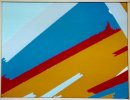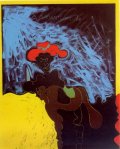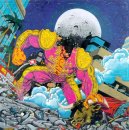|
Up to very recent times, the private art galleries in Rome have been among
the most revealing and interesting catalysts to discover and take the
pulse of what kind of position Art holds in this city. In this sense,
galleries have long been privileged, as have museums and other exhibition
centres, for the interpersonal relationships they create by offering a
cosier setting and the chance of hosting regular meetings.
And so, last August we approached the owner of one of the busiest
galleries of contemporary art in Rome, Francesco Soligo, who for nearly
thirty years had represented, between 1971 to 1998, numerous artists who
have contributed to the building of recent art history. Our interview is
both rare and precious because this Roman gallery owner is no longer with
us; he passed away this year at the age of only fifty-two. However, his
much-loved work remains with us. The work to which he was dedicated, with
the making of careful choices often difficult and against the stream, gave
life to the Soligo Gallery, in the Seventies. Up to a short time ago, the
Soligo — a microcosm that was quickly to become part of the most important
galleries in the city - was situated half way down Via del Babuino and has
contributed greatly to Italian art and culture.
The Soligo Gallery opened officially in 1971 with an exhibition of Giulio
Turcato followed immediately by the show of Mario Schifano, then one of
the most representative of the "Scuola di Piazza del Popolo". Soligo opted
for experimental trends from the start, like many others who declared that
all the new tendencies, being proposed by the contemporary artists, not
only did not destroy every expressive form of art, but, on the contrary,
contained the seed of an artistic regeneration and a new way of exploring
life. Cultural life in Rome in those years favoured meetings and exchange
of artistic experience among the intellectuals. We can look back on the
endless parties and dinners often put together at the last minute and held
in the artists´ studios in Via Margutta and in the villas of Roman
princesses, from Romana Adami to Marta Marzotto and Giorgio Franchetti.
Real gatherings of all the arts. There, you could meet poets, painters,
writers and film directors. Some taverns like Naride and Cesare Menghi´s
were regular meeting points for Mafai, Consagra, Omiccioli, Scarpitta,
Leoncillo, Turcato, and Carla Accardi with her husband Totò Sanfilippo. At
the same time "Da Cesaretto" was a popular place for Sandro Penna, Achille
Perilli, Gabriele Baldini and others to have discussions over a plate of
spaghetti and a glass of wine.
Soligo had lived in this atmosphere since he was a boy, when he would
frequently call on Afro in his studio. Afro was a family friend, and there
Soligo would find parties and unexpected guests. Sometimes, on going to
Turcato´s studio, he would mingle with film directors, actors, and even
artists like Dorazio or Corpora. And in his own way, with many others, he
tried to absorb all the new ideas of that period, channelling them into
his gallery and creating a gathering of intellectuals which has nourished
four generations of artists bound to him by reciprocal friendship and
respect. In fact, it was Corpora at the beginning who introduced him to
Dorazio, and through Afro he met the Genoese painter Scanavino. Both gave
him helpful advice in his first steps as a gallery owner. Once he had met
Schifano, who then introduced Festa and Angeli to him, Soligo chose to
follow the young artists, his contemporaries, to discover with them
alternative ways in art. He preferred working with his own people, as
inter-gallery collaboration is not usual in Rome, because each gallery
follows its own line of thought and judgement. Personal relationships with
the artists were a fixed parameter of discussion and dialogue for him, so
much so that the Gallery had no particular line but moved lithely
according to the latest art trends. His criteria in choosing who to work
with was always based on how the art work reflected the inward motivations
of the painter himself. His meeting with Turcato is an example. That man
"of continuous intellect" involved him in the ‘painting game´, always
coming up with new, significant ideas. Soligo´s numerous business trips
with the Mantuan painter were precious sources of comparison for both of
them, and deepened their cultural and human knowledge.
As regards the relationships between artists, on the other hand, there are
many famous anecdotes told about actual happenings which recall the
artistic atmosphere of twenty years ago. Turcato, for instance, was
convinced that Emilio Vedova, a fellow-student in his Academy days and
afterwards his deadly rival, had once paid two henchmen, in Venice, to
dump him, Turcato, in a canal. In all probability, it was Turcato himself
who (being very drunk) had accidentally fallen in. In the same way, there
is one well-known story about Afro, who had left his studio to the two
Venetian painters and came back to find it like a battle field, with a
Frau armchair completely ruined, because the leather had been used to mend
their shoes, and a toilet had been filled with empty paint tubes. These
seem to be stories of petty jealousies and rivalry, told for fun, rather
than a real professional hostility. Another anecdote is about Aldo Mondino
who, during his first show at Liverani´s art gallery "La Salita", found,
to his horror, that his paintings had been shifted out into the street by
the other Gallery artists who considered them ‘intruders´. At that time,
in fact, the rival battles were mainly cultural and technical, and were
born from long arguments and discussions in the studios, and from a
conscious desire to renew artistic language even if it conflicted with the
realistic lines laid down by Togliatti. But, nowadays, there is tougher
competition between colleagues which leads to voluntary isolation due to
radical changes in the system, such as the crisis of more and more gallery
closures and the development of television marketing.
Enriched in the course of time by the presence of Renato Mambor and Cesare
Tacchi, the period of the "Scuola di Piazza del Popolo" was followed up by
a second generation of painters, with whom Soligo had already been
proposing various new tendencies in research, since 1976. Costantino
Marino and Nicola Maria Martino, presented by Montanarini, former Director
of Rome Fine Arts Academy, were part of his circle. Martino, with his
particular visual poetry, was nearer in character to the Roman Gallery
owner, and introduced to him some of his protégés, among whom was Alberto
Parres. Parres, who was one of the painters followed by Soligo during the
evolution of his research, based his personal type of gestural art on the
recollection of post-informal trends.
Another artist who is still working today in the Gallery is Cesare
Berlingieri, who was introduced to Soligo in 1978 by Ciccio Alliata, a
Sicilian nobleman whose guest he was in the cultural evenings in Monreale.
At the time, Berlingieri was painting in the style of Tàpies, but one
could already catch a glimpse of his future work in his small projects
with their transparent play of canvas on canvas, which was consolidated in
the famous, Conceptual "Piegature" (Folds). Afterwards, Esteban Villalta
Marsi, whose expressive research was permeated by a very sharp chromatism,
joined the Gallery artists. His research uses the stylised language of
Cartoons in a kind of all-Italian Pop Art, to photograph contemporary
reality.
During the Eighties, the new group found in the Soligo Gallery a meeting
point that was gradually disappearing from the Roman parlours. In the
meantime, Schifano, Angeli, Festa and the other masters of the previous
generation continued with their exhibitions at Studio Soligo. In fact, the
Soligo still keeps the historic archives of Tano Festa. In this decade,
the public was still curious and a vernissage was still a cultural event,
attracting artists, well-known personalities, photographers, critics and
specialised journalists. However, it is in the Nineties that we begin to
feel a decline in gallery-culture as such. Yet, in this difficult
atmosphere of transition, Soligo added another painter to his group,
Fabrizio Campanella. This Roman artist offers us an ulterior conception of
form on canvas structurally and chromatically measured in a vigorous,
musical rush of visual rhythms.
The Studio Soligo has now entered a new stage. This will be inaugurated in
Milan by Raffaele and Giulio Soligo – Francesco´s sons – where a branch
gallery has opened in Via Pontaccio 19, and in Rome, where the Soligo
Gallery has moved into the historic Via Margutta 49. This area, in fact,
has been chosen by various qualified operators among whom we also can
mention Galleria Banchi Nuovi. In the city of Milan, on the other hand,
the art market is very much alive and growing, together with collaboration
among galleries. This really does indicate a closer contact with the art
collectors who have always been behind the continual renewal of the art
game.
|
 ill. 1
ill. 1 ill. 2
ill. 2 ill. 3
ill. 3 ill. 4
ill. 4